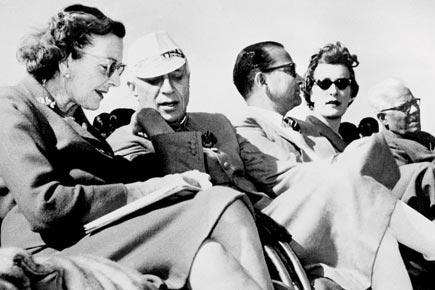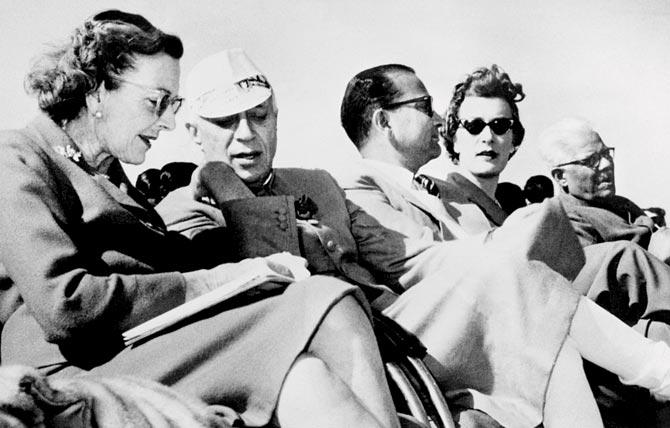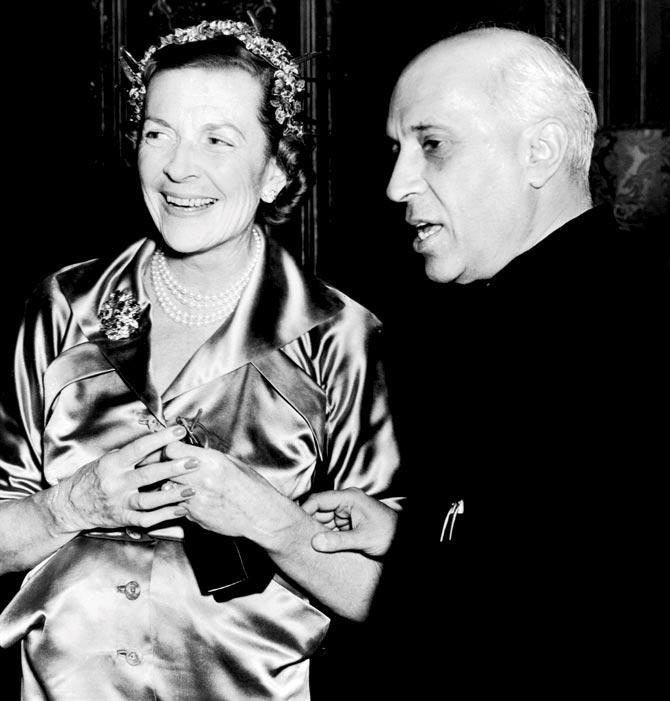A fictional friend of India's last Vicerine retells the romance between Edwina Mountbatten and Jawaharlal Nehru. UK author Rhiannon Jenkins Tsang on writing the most romantic tale from the era

A 1959 photograph of Pandit Jawaharlal Nehru talking to Lady Mountbatten during a display at New Delhi's Glider Club. Pic/STF/AFP/Getty Images

A 1959 photograph of Pandit Jawaharlal Nehru talking to Lady Mountbatten during a display at New Delhi's Glider Club. Pic/STF/AFP/Getty Images
I saw them — Edwina and Jawahar. Caught in a halo of light from the stage, they sat in the centre. In that moment everything that was happening seemed to be spinning off them, happening because of them, and in some way connected to them. Edwina was sitting on a sofa, watching a performance of Indian dance. He was crosslegged at her feet. It was written on their faces, in the turn of her head and the angle of his back against the sofa, pressing too close to the hems of her skirt. Whether they knew it or not, it was unveiled for all the hundreds to see.
ADVERTISEMENT
The lines, as relayed through Letty Wallace, a character, who is introduced as an old school friend of Edwina, known to the world as Lady Mountbatten, in UK-based author Rhiannon Jenkins Tsang's new historical novel, The Last Vicereine (Penguin), is both dramatic and romantic, for the repercussions this blossoming friendship could have had on the already strained relations between Indian and Britain. Yet, Tsang, who fictionalises the Vicereine's life in this brazen new book, says it's the romance that compelled her to write the novel. "Neither of them [Edwina and Jawaharlal Nehru] was young when they first met in Singapore (in 1946) after the war. She was in her late 40s and he, in his 50s. Popular fiction and cinema would suggest that love is the prerogative of the young. It isn't, and I was attracted to the challenge of telling a great love story between two older people, who might more easily have been considered enemies," says Tsang.

Edwina Mountbatten and Jawaharlal Nehru at a reception given for him by the Indian High Commissioner in London in February 1955. Pic/Getty Images
She says the germ of the idea was sown three summers ago, while she was on holiday in France. "It kept me awake all night," she remembers. Following months of intense research, which included reading Nehru's works, diaries and recollections of people, who were involved in the transfer of power in India at the time, and after visiting the Mountbatten Archives at Southampton University, Tsang finally got down to writing. She clarifies, though, that she didn't have direct access to the letters exchanged between Edwina and Nehru, as they are still under an embargo at the archives centre. "For the tone and content of the correspondence, I relied on the work of writer Janet Morgan. Many years ago, she had sight of some letters from both parties before the embargo was set up. I also undertook a field trip to India," says Tsang, who previously read Oriental Studies at Oxford University.
In the novel, it's Letty, who takes the story forward, becoming the observer and the voice of Tsang's narrative. "Edwina had two female English members of staff with her in India. Both are named in biographies and diaries, however, neither of these ladies appear to have ever kept diaries or published recollections. In this gap, I saw an opportunity to invent the character of Lady Letticia (Letty) Wallace, and weave a story around the pillars of historical fact," she says.

Rhiannon Jenkins Tsang
While one can't deny that in doing so, the author is toeing a thin line between fact and fiction, Tsang argues that historical fiction has always been about imagining credible stories in the blanks left by historical records. The book, she maintains, was not written with the approval of either the Mountbatten or Gandhi-Nehru families. "Why would I need to do that? It's simply a great love story that I had to tell. It owes nothing to anyone," Tsang insists. "I do not see the need for a disclaimer. My work is well-researched and written with great respect."
But, pigeonholing the book as a love story between two iconic figures would be limiting the tale of an otherwise zealous woman, who the author likens to Princess Diana. Like Diana, Tsang says, Edwina found her place in the world by dedicating herself to those in need in the aftermath of the Partition. "She never stopped, took great personal risk, and drove her own health into the ground. Nehru knew how hard she worked," says Tsang. His farewell tribute to Edwina, perhaps, best encapsulates it: "Wherever you have gone you have brought solace, and you have brought hope and encouragement. Is it surprising, therefore, that the people of India should love you and look up to you as one of themselves and should grieve that you are going?"
 Subscribe today by clicking the link and stay updated with the latest news!" Click here!
Subscribe today by clicking the link and stay updated with the latest news!" Click here!







